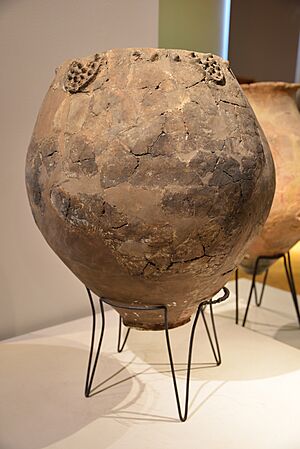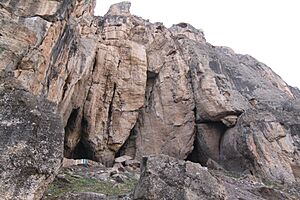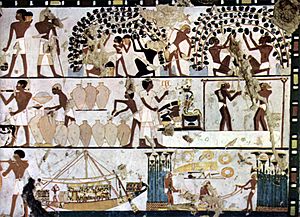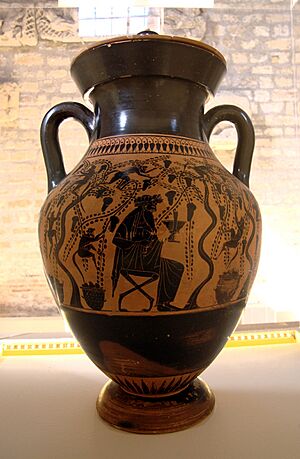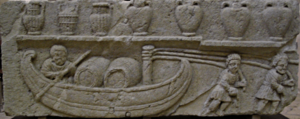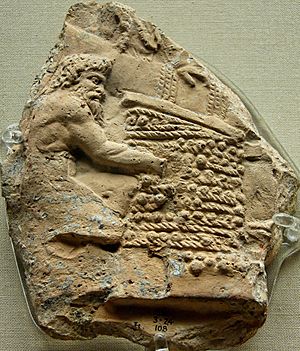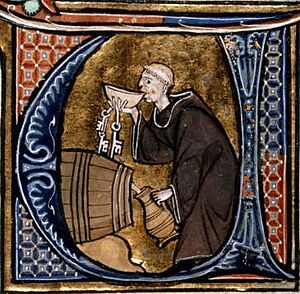History of wine facts for kids
Wine, a popular drink made from fermented grapes, has a very long history! The earliest signs of wine making have been found in Georgia around 6000 BC. Other ancient discoveries include sites in Iran (around 5000 BC), Greece (around 4500 BC), Armenia (around 4100 BC, where large-scale production began), and Sicily (around 4000 BC). Some experts also believe that a fermented drink made from rice, honey, and fruit found in China (around 7000 BC) might be an early form of wine.
Ancient civilizations like the ancient Greeks and Romans honored gods of wine, such as Dionysus and Bacchus. Wine was also important in religious practices, like in Jewish traditions and Christian ceremonies. Even though Islam generally discourages alcohol, during its Golden Age, smart scientists called alchemists found ways to distill wine. This process created pure alcohol, which was used for medicines and perfumes.
Wine making and drinking grew a lot, especially from the 1400s onwards as Europeans explored the world. Even after a tiny bug called phylloxera caused huge damage to grapevines in 1887, new science and technology helped the wine industry recover. Today, wine is made and enjoyed all over the world.
Contents
How Wine Began: Ancient Times
Taming Wild Grapes
The story of wine starts even before people wrote things down. Scientists are still learning how wild grapevines were first grown by humans. It's thought that early humans climbed trees to pick berries. They liked the sweet taste and started collecting them. If juice was left in a container for a few days, it would naturally start to ferment and turn into a low-alcohol wine. This changed around 10,000 to 8000 BC when people stopped moving around and started farming. This led to growing grapes on purpose and making wine.
Making wine became easier after people learned to make pottery around 11,000 BC. Pottery allowed them to store liquids. After Christopher Columbus's voyages, grape growing and wine making traveled from Europe to the Americas. Spanish missionaries brought grapevines to Chile and Argentina in the mid-1500s, and to California in the 1700s. Later, in the 1800s and early 1900s, many European immigrants came and started modern wine industries using European grapes. Important wine regions in South America grew in the Andes Mountains, and in California, wine making spread to areas like Sonoma and Napa.
The First Wine Makers
The oldest signs of wine making have been found in Georgia (around 6000 BC), Iran (around 5000 BC), Greece (around 4500 BC), and Sicily (around 4000 BC). The first clear evidence of steady wine production was found in Armenia (around 4100 BC). In ancient China, a fermented drink made from grapes and rice was found from around 7000 BC. The ancient jars from Iran contained a type of wine called retsina, which used pine resin to seal and preserve the wine better.
The oldest known winery was discovered in the "Areni-1" cave in Armenia. It dates back to about 4100 BC. Inside, archaeologists found a wine press, large pots for fermenting, jars, and cups. They also found seeds and vines from Vitis vinifera, the same type of grape used for wine today. This discovery shows that wine making was already very advanced back then, suggesting it started even earlier.
The fame of Persian wine was well known in ancient times. Carvings on the Apadana Palace in Persepolis show soldiers from different lands bringing gifts, including wine, to the Persian king. Domesticated grapes were common in the Near East from the start of the early Bronze Age, around 3200 BC. There is also growing evidence of wine making in Sumer and Egypt in the 2000s BC.
Fun Stories About Wine's Discovery
Many old stories explain how grapevines were first grown and how wine was discovered.
The Biblical Book of Genesis says that Noah made wine after the Great Flood.
In Greek mythology, the god Dionysus learned how to grow grapes and make wine on Mount Nysa. He then taught this skill to people in central Anatolia. Because of this, he became the god of wine.
A Persian legend tells of King Jamshid who banished a lady from his palace. She became very sad and went to the king's storage room. She found a jar labeled "poison" that contained spoiled grapes. After drinking the fermented juice, she felt much better. She told the king about her discovery. He loved the new drink so much that he took her back and ordered that all grapes grown in Persepolis be used for wine.
Wine in Ancient Civilizations
China's Early Drinks
Archaeologists have found signs of wine production from native "mountain grapes" in China around 1000 BC. By the time of the Han dynasty, beer drinking had mostly stopped in China. People preferred stronger drinks made from millet, rice, and other grains. These drinks, called huangjiu, are often translated as "wine" but are usually around 20% alcohol and are different from grape wine in China.
Around 200 BC, a Chinese explorer named Zhang Qian traveled to Western regions. He reached areas that were once part of Alexander's empire, where grape growing had been introduced. Through trade, the first wine made from European grapes came to China.
Wine was imported again during the Tang dynasty, but it was mostly for the emperor. It wasn't until the Song dynasty that it became popular among rich people. Marco Polo wrote in the 1300s that people in China still preferred rice wines.
Wine in Ancient Egypt
Wine was very important in ancient Egyptian ceremonies. A successful royal wine industry started in the Nile Delta after grape growing came to Egypt from the Levant around 3000 BC. This industry likely grew from trade between Egypt and Canaan during the early Bronze Age. Scenes of wine making on tomb walls show that wine was produced in the delta vineyards. By the end of the Old Kingdom, five different wines, probably all from the Delta, were considered essential for the afterlife.
Most wine in ancient Egypt was red. Because it looked like blood, there were many superstitions about drinking wine in Egyptian culture. Shedeh, a very valuable drink, is now known to have been a red wine, not a pomegranate drink as once thought. The writer Plutarch said that before a certain pharaoh, Egyptian rulers didn't drink wine or offer it to the gods. They thought it was the blood of those who fought against the gods and from whom grapevines grew.
However, scientists found traces of white wine in five clay jars from Tutankhamun's tomb. This shows that white wine was at least available to Egyptians through trade, even if they didn't make it themselves.
Wine in the Ancient Levant
The Levant region, which includes modern-day Israel, Lebanon, and parts of Syria and Jordan, was very important for wine making in ancient times. Archaeologists have found charred grape seeds and even whole grapes in many old sites. Wine making here has deep roots, going back to at least the Bronze Age. It remained a major industry until the Byzantine Empire declined in the 600s AD. This long history of wine making greatly enriched the culture and economy of ancient societies in the region.
The ancient Phoenicians were among the first to understand the importance of growing grapes and trading wine. They lived along the eastern Mediterranean coast and used their location to trade far and wide. The prophet Hosea (780–725 BC) encouraged his followers to return to God, saying they would "blossom as the vine" and smell "like the wine of Lebanon". The Phoenicians used large clay jars called amphoras to transport wine, and this method was widely copied. The grape varieties they traded helped develop the wine industries in Rome and Greece. The Phoenicians also started colonies along the Mediterranean, introducing grape growing there. One famous colony was Carthage. The only Carthaginian recipe to survive wars was for passum, a raisin wine that later became popular in Rome.
Wine was very important in ancient Israelite cuisine. It was a common drink and a key part of their cultural and religious practices.
Later, during Late Antiquity, when the Levant was controlled by the Byzantine Empire, the region became a famous center for wine making. Ashkelon and Gaza, two old port cities, became important trade hubs, sending lots of wine across the Byzantine Empire. Writings from the 300s AD describe the Holy Land covered with vineyards. Wines from this region were known for being white, light, and sweet.
In the Arabian peninsula, where the climate wasn't good for growing grapes, wine was traded by Aramaic merchants. However, many other fermented drinks were made there in the 400s and 500s, including date and honey wines.
Recent discoveries show that wine was also made in southern Samaria during the Iron Age and Persian Period. This included many wine presses and pits, showing that industrial wine production was not just in central Judea. Wine was made throughout southern Samaria, even near the desert. Some of these sites date back to the Northern Kingdom and continued under Assyrian and Persian rule.
Wine in Ancient Greece
Much of how we think about wine today comes from the ancient Greeks. Grapevines were grown in Greece even before the Minoan and Mycenaean cultures. Many grapes grown in Greece today are unique to the area and are similar to those grown long ago. For example, the popular Greek white wine called retsina is thought to come from an ancient practice of lining wine jugs with tree resin, which gives the wine a special flavor.
The "Feast of the Wine" was a festival in Mycenaean Greece celebrating the "Month of the New Wine." Ancient writers describe how the Greeks used gypsum (a mineral) before fermentation and lime after to reduce the wine's sourness.
In Greek stories, wine was usually mixed with water in "mixing bowls" before being drunk. Dionysus, the Greek god of parties and wine, was sometimes called Acratophorus, meaning "giver of unmixed wine." The poet Homer often described the sea as "wine-dark" because the Greeks didn't have a word for the color blue, so they used the color of red wine.
The earliest mention of a specific wine is from the 600s BC, when a poet praised Dénthis wine from Mount Taygetus as "flowery-scented." Chian wine was known as the first "black wine" (red wine). Coan wine was mixed with seawater and was famously salty. Lesbian wine was also a famous export. Aristotle mentioned Lemnian wine, which might be the same as the modern-day Lemnió grape, a red wine that smells like oregano and thyme. If so, Lemnió is the oldest known grape variety still grown today.
For Greece, wine became a valuable "cash crop" as its economy grew. Greek wine was well known and traded across the Mediterranean. Jars with Greek designs have been found all over the area. The Greeks may have even been involved in the first appearance of wine in ancient Egypt. They brought the V. vinifera vine to their many colonies in modern-day Italy, Sicily, southern France, and Spain, and made wine there.
Wine in Ancient Persia
The historian Herodotus wrote that the ancient Persians loved wine and drank a lot of it.
Wine in Ancient Thrace
The writings of Homer, Herodotus, and other ancient Greek historians mention that the ancient Thracians loved making and drinking wine as early as 6000 years ago. The Thracians are believed to be the first to worship the god of wine, called Dionysus by the Greeks or Zagreus by the Thracians. This worship later spread to Ancient Greece. Some people consider Thrace (modern-day Bulgaria) to be the birthplace of wine culture.
Wine in the Roman Empire
The Roman Empire had a huge impact on how grapes were grown and how wine was made. Wine was a key part of the Roman diet, and making it became a very organized business. Almost all the major wine-producing regions in Western Europe today were started during the Roman Empire. Wine growing expanded so much that around 92 AD, Emperor Domitian had to create the first wine laws. He banned planting new vineyards in Italy and ordered half of the vineyards in the Roman provinces to be removed. This was done to grow more grain, which was needed but less profitable. (People mostly ignored this rule, but it stayed until it was canceled in 280 AD.)
Wine making technology got much better during the Roman Empire. They still used some older methods, but also added new ideas. For example, they built wine storage rooms facing north because that direction was always cool. They also used special smokehouses to make wine age faster or seem older. Many new grape varieties and growing techniques were developed. Barrels (invented by the Gauls) and glass bottles (invented by the Syrians) started to be used alongside clay jars for storing and shipping wine.
The Romans also created a system similar to today's wine regions, where certain areas became famous for their good wines. The most famous was the white Falernian wine from the border of Latium and Campania. It was popular because it had a high alcohol content (around 15%). The Romans recognized three types of Falernian wine: from the highest slopes, from the middle (named after a famous owner), and a general one from the lower areas. These valuable wines became more expensive as they aged. Other famous wines included the sweet Alban wine and the Caecuban wine.
Wine, sometimes mixed with herbs and minerals, was thought to have medicinal uses. Rich Romans might dissolve pearls in wine for better health. Cleopatra famously dissolved an expensive pearl in a cup of wine to show Mark Antony she could "drink the value of a province." The writer Pliny the Elder said that after Emperor Augustus came to power, Setinum wine became the imperial wine because it didn't cause him indigestion. When the Western Roman Empire fell in the 400s, Europe entered a time of trouble. The Roman Catholic Church was the only stable group, and it helped keep grape growing and wine making skills alive, as wine was essential for Mass.
Later in the Empire, wine production slowly moved east as Roman power in the west weakened. Wine making in Asia Minor, the Aegean Sea region, and the Near East grew during the late Roman and Byzantine eras.
The oldest surviving bottle of liquid wine, the Speyer wine bottle, belonged to a Roman nobleman and dates back to 325 or 350 AD.
Wine in the Middle Ages
Wine in the Medieval Middle East
When Islam spread in the 600s and 700s, many areas came under Muslim rule. Alcoholic drinks were forbidden by law, but wine production still seemed to do well. Wine was a topic for many poets, even under Islamic rule. Jews in Egypt rented vineyards from the Fatimid and Mamluk governments. They made wine for religious and medical uses, and traded it across the Eastern Mediterranean.
Christian monasteries in the Levant and Iraq often grew grapevines. They then sold their wines in taverns located on monastery lands. Zoroastrians in Persia and Central Asia also made wine. While not much is known about their wine trade, they were known for their taverns. Wine also found an industrial use in the medieval Middle East. After scientists called alchemists made progress in distillation, they could produce pure alcohol from wine. This alcohol was used in the perfume industry. Wine was also distilled into brandy for the first time during this period.
In the Levant, the Muslim conquest stopped wine making after centuries of it being very important. By the 1200s, the Mamluk conquest led to it being completely forbidden.
Wine in Medieval Europe
In the Middle Ages, wine was the common drink for everyone in southern Europe, where grapes were grown. In the north and east, where few grapes grew, beer and ale were the usual drinks. Wine was sent to northern regions, but it was expensive, so common people rarely drank it. However, wine was needed for Catholic Mass, so ensuring a supply was very important.
The Benedictine monks became some of the biggest wine producers in France and Germany, followed closely by the Cistercians. Other religious groups also made wine. The Benedictines owned vineyards in famous French regions like Champagne, Burgundy, and Bordeaux, and in German regions like the Rheingau. In 1435, Count John IV of Katzenelnbogen was the first to plant Riesling, which is now Germany's most important grape. Nearby monks turned it into a big industry, making enough wine to send all over Europe for everyday use. Portugal, a country with one of the oldest wine traditions, created the world's first system for naming wine regions.
A housewife or servant in a noble home would have served wine at every meal, both red and white. Recipes for mead (a honey drink) from this time still exist, along with ways to spice or cover up flavors in wines, like adding a little honey. Since wines were kept in barrels, they weren't aged for long and were drunk quite young. Wine was often watered down, with four or five parts water to one part wine, before drinking.
One medieval use for wine was to dissolve "snake-stones" (a type of agate) in it as a cure for snake bites.
Jofroi of Waterford, a monk from the 1200s, wrote a list of all the known wines and ales in Europe, describing them with great detail. Rashi, a French rabbi from the Middle Ages, who wrote important commentaries on religious texts, earned his living as a wine maker.
Some medieval names for types of wine included "pimentum" and "malmsey".
Modern Wine History
Wine Spreads to the Americas
European grape varieties were first brought to what is now Mexico by Spanish explorers. They needed wine for Catholic religious ceremonies. One type of grape became known as the Mission grape and is still grown today. Later, immigrants brought French, Italian, and German grapes. However, wine is also made from grapes native to the Americas, which taste quite different. Mexico became the most important wine producer in the 1500s. Its wine production grew so much that it started to affect Spain's wine trade. Because of this, the Spanish king ordered Mexico to stop making wine and planting vineyards.
In the late 1800s, a tiny bug called phylloxera caused huge damage to grapevines in Europe. It was discovered that Native American vines were immune to this pest. New types of grapes, called French-American hybrids, were developed and used in Europe. More importantly, European grapevines were grafted (joined) onto American rootstocks to protect them from the insect. This practice continues today wherever phylloxera is a problem.
Today, wine in the Americas is often linked with Argentina, California, and Chile. These regions produce many different wines, from inexpensive ones to high-quality special blends. Most wine production in the Americas uses Old World grape varieties. Wine-growing regions there have often "adopted" grapes that have become strongly connected with them. For example, California's Zinfandel (originally from Croatia and Southern Italy), Argentina's Malbec, and Chile's Carmenère (both from France) are well-known examples.
Until the late 1900s, American wine was generally seen as not as good as European wine. However, after American wines surprisingly did very well at the Paris Wine tasting of 1976, wines from the "New World" (like the Americas) started to gain respect in Europe, where wine originated.
Changes in European Wine
In the late 1800s, the phylloxera louse caused widespread destruction to grapevines, wine production, and the lives of those who depended on them. This led to many local grape varieties being lost. However, the lessons learned from this disaster led to positive changes in Europe's wine industry. Bad vineyards were removed, and the land was used for better things. For example, some of France's best butter and cheese now come from cows that graze on land that was once covered with grapevines. Wine blends were also standardized, which was important for creating the famous wines we know today, like Champagne and Bordeaux. In the Balkans, where phylloxera had less impact, local grape varieties survived. However, the changes from Ottoman rule meant that many vineyards changed slowly. Only recently have local varieties gained recognition beyond common "mass-market" wines like retsina.
Wine in Australia, New Zealand, and South Africa
In the world of wine, Australia, New Zealand, South Africa, and other countries without a long wine tradition are considered "New World" producers. Wine production began in the Cape Province of what is now South Africa in the 1680s to supply ships. Australia's First Fleet (1788) brought grape cuttings from South Africa. Although the first plantings failed, successful vineyards were started in the early 1800s. Until quite late in the 1900s, the wines from these countries were not well known outside their small export markets. For example, Australia mainly sent wine to the United Kingdom; New Zealand kept most of its wine for its own people, and South Africa exported to European kings. However, with more machines and scientific advances in wine making, these countries became known for high-quality wine. An interesting fact is that the Cape Province was the largest exporter of wine to Europe in the 1700s.
Wine in East Asia
In East Asia, the first modern wine industry was Japanese wine, which started in 1874 after grapevines were brought from Europe. The earliest wine companies in Japan include Suntory and Mercian.
|
See also
 In Spanish: Historia del vino para niños
In Spanish: Historia del vino para niños


